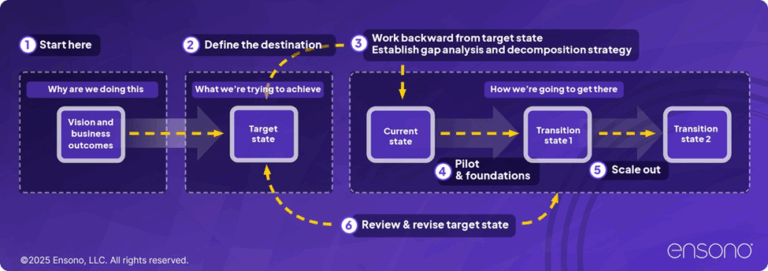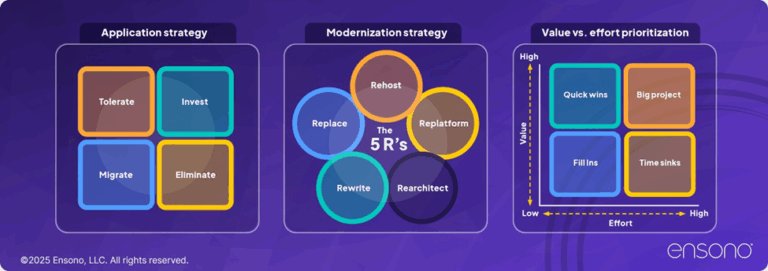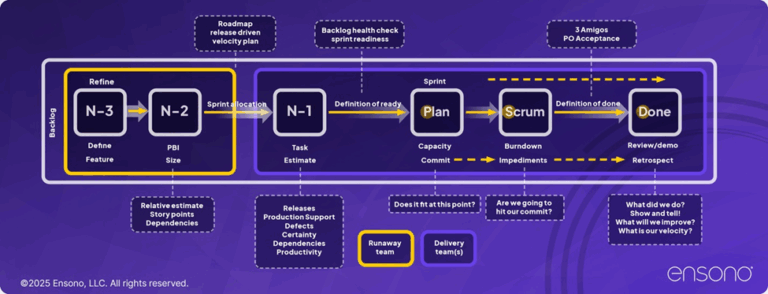The SMART Way to Modernize Applications

Andrew Jutton
Practice Director, Modern Application Development
Learn how Ensono’s SMART, execution-focused approach to application modernization helps organizations modernize with purpose, clarity, and confidence.
———————————
While many organizations understand the need to evolve their digital strategies and technologies to keep pace with change, few have a clear path to application modernization execution. The real differentiator lies in how modernization is approached. It should be a continuous, strategic, and collaborative journey that focuses on delivering business value by asking “why,” “what,” and “how” at every stage.
Continuous, incremental modernization focuses on investing in the drivers for change to make your technology landscape evergreen.
A SMART Path Forward
Application modernization should address key business challenges, such as:
- Overcoming slow delivery
- Eliminate legacy constraints of aging systems
- Inability to meet service level demands to support platform stability and growth
- Address cost pressures
- Break innovation barriers
Understanding your organization’s business goals, pain points, and future vision is essential to define the “why,” establish objectives, and identify business value. SMART (Specific, Measurable, Achievable, Relevant, Time-bound) goals help translate these into quantifiable actions. Here are example SMART goals that illustrate how modernization delivers measurable business impact to deliver value-driven business outcomes.
| Goal | Metric | Method | Timeline |
| Reduce operational costs | Up to 20% | Consolidate environments to public cloud, enable auto-scaling to reduce overprovisioning | 1 year |
| Enhance productivity | Up to 20% | Adopt a serverless infrastructure, reduce time spent on repeatable tasks | 1 year |
| Reduce release risk | Up to 50% | Use canary and blue/green deployments, break monoliths into independently deployable services | 2 years |
| Improve time to market | Up to 40% | Automate manual tasks, adopt modern development practices | 2 years |
| Reduce website errors | Up to 25% | Improve observability to diagnose issues within 1 hour | 6 months |
| Boost customer satisfaction | Page load within 2 seconds | Stabilize website, optimize performance by meeting performance quality targets | 2 years |
Turning Strategy into Execution
These example SMART goals provide a clear framework for measuring the impact of modernization but achieving them requires more than just setting targets. Success depends on the strategies, practices, and cultural shifts that support execution. The following key factors are essential to turning SMART goals into real business outcomes and sustaining modernization momentum across your organization.
Strategic Vision
Start with the problem, not the solution. Identify the problems first—rising costs, slow delivery, technical debt—and then design logical architectures that deliver measurable outcomes and business value.
A successful modernization starts with a clear strategic vision—anchored in a business case, goals and objectives with clear criteria, and an incremental roadmap. A “why, what, and how” framework helps define the purpose, future state, and execution path.
Figure 1 highlights the key differences between legacy and modernized applications—and why the shift is essential.

Agile Delivery
Deliver modernization in incremental, value-driven phases. Each application should be independently deployable with clear rollout and rollback strategies. Start with a pilot sized for impact—not too small to be inconsequential, and not too large to be risky. A successful pilot validates the approach, builds confidence, and establishes repeatable patterns.
Application rationalization is key:
- Assess each application’s value, criticality, goals, architecture, risk level, and modernization potential to determine the right modernization strategy for each application and capability.
- Robust integration is essential. Use modern patterns to connect legacy and modernized systems, enabling seamless functionality across environments.

Better Tooling
Use automation to accelerate modernization, but make sure it’s guided by strategy and not driven by tooling alone. AI tooling can accelerate the understanding of legacy applications—especially when documentation is sparse or subject matter experts are no longer available. It enables deep analysis of dependencies, security gaps, and compliance issues, while also helping extract embedded business logic to inform future design decisions.
To support SMART goals like reducing release risk, improving time to market, and reducing website errors, adopt modern deployment practices (e.g., canary, blue/green), improv observability, and reduce manual tasks.
Best Practice Execution
Modernization succeeds with strong collaboration and embedded expertise. Break down silos and promote collaboration within development teams through shared ceremonies and active stakeholder engagement.
Bring in the experts to help. Ensono, for example, promotes a hybrid approach to working—collaborating closely with client teams to build solutions together. This includes embedding skills into the client organization and establishing Centers of Excellence to support future project delivery.
Effective Leadership
Strong leadership is essential to translate vision into execution and align stakeholders. Project management should be flexible and focused on delivering value early. Architecture designs and requirements should be delivered in time for refinement and planning, assuring shared understanding and high-quality outcomes.
Establish an architecture governance board that brings business and technical stakeholders together to review solution options. Document key decisions to confirm alignment, knowledge-transfer, and traceability.
Modernization thrives when progress is tracked and validated through data. Effective modernization efforts should strategically mix short-term wins with long-term vision. Use metrics like DORA (Deployment Frequency, Lead Time for Changes, Change Failure Rate, Time to Restore Service) to track modernization progress, validate outcomes, and guide continuous improvement.

Application Modernization isn’t a Milestone—it’s a Mindset
Ensono helps organizations move beyond application modernization strategy into execution, with a focus on outcomes, embedded collaboration, and scalable delivery. Whether you’re starting small or transforming enterprise-wide, success comes from aligning vision with action—and building a technology landscape that’s modern and built to evolve.
In this white paper, we describe our approach to rethinking application modernization and how to turn your applications into assets.
———————————–
Frequently Asked Questions:
How does continuous modernization benefit IT and business teams?
Continuous modernization creates alignment between evolving business goals and the technology that supports them. By continuously modernizing, IT teams can deliver faster, more secure solutions—while business teams gain agility to respond to market shifts.
How do SMART goals support application modernization?
SMART (Specific, Measurable, Achievable, Relevant, Time-bound) goals translate business objectives into actionable, trackable modernization outcomes.
Is application modernization a one-time project or an ongoing process?
It’s an ongoing journey. Ensono advocates for continuous modernization—a strategic approach that evolves with your business and keeps your technology landscape evergreen.
What if we’re not ready for a full transformation?
That’s okay. We recommend starting with a pilot project that’s sized for impact. It helps validate the approach, build internal confidence, and create repeatable patterns for broader rollout.
How do we measure success in application modernization?
Success is tracked using outcome-based metrics like deployment frequency, lead time for changes, and change failure rate. These help validate progress and guide continuous improvement.
Social Share
Don't miss the latest from Ensono
Keep up with Ensono
Innovation never stops, and we support you at every stage. From infrastructure-as-a-service advances to upcoming webinars, explore our news here.
Blog Post | December 4, 2025 | Industry trends
Managing Technical Debt Starts with Smarter AI Governance
Blog Post | November 19, 2025 | Research Reports
The 5 Things Every IT Leader Needs To Know About Modernization In 2026
Blog Post | September 24, 2025